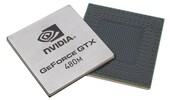NVIDIA GeForce GTX 480M vs NVIDIA GeForce GTX 470M SLI
NVIDIA GeForce GTX 480M
► remove from comparison
The NVIDIA GeForce GTX 480M is a high-end graphics card for laptops based on the Fermi architecture. As a result, it supports DirectX 11 and is produced in 40nm at TSMC. Featuring 352 cores, the GTX480M is similar to the desktop GTX 465 but with a lower clock rate. The GeForce GTX 480M is combined with 2 GB of fast dedicated GDDR5 graphics memory and the overall performance should be generally superior to the Mobility Radeon HD 5870.
The GF100 (aka. Fermi) chip was redesigned from scratch and features 3 billion transistors, assuming all 512 shaders are present. Compared to the desktop HD 5870 with 2.13 billion transistors or the Mobility Radeon HD 5870 (RV870) with 1.04 billion transistors, the GTX 480M die is physically quite large.
The mobile Fermi chip is stripped down to 352 shader cores (1-dimensional) with 32 ROPs and 44 Texture Units. The memory bus is 256 bit wide, but due to the fast GDDR5 memory, this should not be a bottleneck. The power consumption has been specified to 100 Watt TDP when taking into account the MXM board and the 2 GB GDDR5. AMD usually specifies the TDP of the chip alone, therefore this value is not directly comparable with competing Radeon cards. Still, the GTX 480M is only suited for very large desktop replacement (DTR) laptops with an excellent cooling solution. Originally, only Clevo was offering the GTX 480M in its 17" (D901F) and 18" (X8100) barebones.
The performance of the Nvidia GeForce GTX 480M is about 10% better on average than the ATI Mobility Radeon HD 5870. In demanding DirectX 11 games and benchmarks (that make use of the Tessellation engine), the GTX 480M is even faster. That means the GTX480M is the fastest single GPU graphics solution for laptops as of early to mid 2010. Modern DirectX 10 games should run fluently in high resolutions and details with antialiasing. Only very demanding games like Crysis or Metro 2033 may need some reduced settings (see list below). Due to the DirectX 11 hardware support (and the good tessellation implementation), the Fermi based laptop graphics card should be well suited for upcoming DirectX 11 games.
As the GeForce 300M series, the GeForce GTX 480M supports PureVideo HD with VideoProcessor 4 (VP4 with Feature Set C). This means the GPU is able to fully decode HD videos in H.254, VC-1, MPEG-2, and MPEG-4 ASP. The graphics card can also accelerate Flash videos by using Flash 10.1 or greater.
The rendering cores of the Nvidia GeForce GTX 480M can be used for general calculations with CUDA or DirectCompute. For example, the encoding of HD videos can be done significantly faster than most modern CPUs by using the shader cores of the GPU instead. PhysX is also supported by the mobile Fermi chip to calculate physics effects in supported games.
Compared to desktop GPUs, the Geforce GTX 480M is comparable to a nunderclocked Nvidia GeForce GTX 465 (607/1200 clock speed) and is therefore on par with a desktop Radeon HD 5770.
NVIDIA GeForce GTX 470M SLI
► remove from comparison
The NVIDIA GeForce GTX 470M SLI is a high-end graphics solution for laptops based on two GeForce GTX 470M graphic cards in SLI mode. Each card usually renders a single frame in an alternating manner. Therefore, it may suffer from micro stuttering in low fps ranges of 30fps. This happens because of different timespans between two frames (e.g. Irregular delays between sequential frames). Each single GTX 470M is based on the GF104 core and therefore supports DirectX1 11 and OpenGL 4.0.
GF104 architecture
The GF104 core of the GTX 470M is related to the GF100 core of the GeFore GTX 480M that offers 384 shaders and a 256 Bit memory bus for GDDR5. The GTX 470M, however, offers only 288 cores of the 384 and a 192 Bit memory bus. The architecture of the GF104 is not comparable to the old GT215 (e.g., GeForce GTS 350M) or G92b (e.g., GeForce GTX 285M) cores.
Unlike the GF100, the smaller GF104, GF106, and GF108 cores were shortened and considerably modified. In contrast to the GF100, which was designed for professional applications, these chips target the consumer market. They feature more shaders (3x16 instead of 2x16), more texture units (8 instead of 4) and SFUs per streaming multi-processor (SM). As there are still only 2 warp schedulers (versus 3 shader groups), Nvidia now uses superscalar execution to use the higher amount of shaders per SM more efficiently. In theory, the shaders can therefore be utilized more efficiently and the performance per core is improved.
However, in worst case scenarios the performance can also be worse than that of the GF100 (and its predecessors). The ECC memory protection, which is important for professional applications, was completely omitted and the FP64 hardware was shortened (only 1/3 of the shader are FP64-capable and therefore only 1/12 of the performance of the FP32). Because of these cutbacks, the size of the SM grew only by 25% despite the higher number of shaders and larger warp schedulers with superscalar dispatch capabilities. Due to the different shader architectures and the higher clock rate of the shader domain, the core count can not be directly compared to AMD cores of the Radeon 5000 series (e.g. HD 5850).
Detailed information on the GF104 architecture (and by extension also the GF106 and GF108) can be found in the desktop GTX 460 article by Anandtech.
Performance
The performance of the GTX 470M SLI combination should be similar to the GTX 480M SLI due to the high-clocked GTX470M cards. Generally, the SLI gain depends on the used application/game and the driver support. Currently, the SLI driver support from Nvidia is better than the Crossfire support from AMD, leading to higher gains. About 30% more performance is gained on average compared to a single GTX 470M (in high resolutions and with Anti-Aliasing). Therefore, all games from 2010 except Metro 2033 should be playable in the highest detail settings. Metro 2033 only ran with 23 fps in our tests with a GTX 480M SLI system and should therefore score similar on the GTX 470M SLI combination.
Features
A novelty of the GF104/106/108 chips is the support of Bitstream HD Audio (Blu-Ray) output via HDMI. Similar to the Radeon HD 5850, the GTX 470M can transfer Dolby True HD and DTS-HD bitstream without quality loss to a HiFi receiver.
The GTX470M offers the PureVideo HD technology for video decoding. The included Video Processor 4 (VP4) supports feature set C and therefore the GPU is able to fully decode MPEG-1, MPEG-2, MPEG-4 Part 2 (MPEG-4 ASP - e.g., DivX or Xvid), VC-1/WMV9, and H.264 (VLD, IDCT, Motion Compensation, and Deblocking). The X500 tester was able to decode the VC-1 encoded Elephants Dream video with about 3-6% CPU load (according to the task manager). The H.264-encoded Big Buck Bunny video was played back with 1-3% CPU load (both 1080p videos).
Furthermore, the GPU is able to decode two 1080p streams simultaneously (e.g. for Blu-Ray Picture-in-Picture).
Through CUDA, OpenCL and DirectCompute 2.1 support, the GeForce GTX 470M can assist in general calculations. For example, the stream processor can encode videos considerably faster than certain high-end CPUs. Furthermore, physics calculations can be done by the GPU using PhysX (e.g. supported by Mafia 2 or Metro 2033). SLI systems can also dedicate a single card for PhysX calculations.
According to Nvidia, support for 3D Vision on the GTX graphics cards is also new. It enables the laptop to send 3D contents (3D games, 3D Web Streaming, 3D photos, 3D Blu-Rays) to a built-in 3D enabled screen or an external 3D TV (only if supported by the laptop manufacturer).
Unofficially, the power consumption of the GeForce GTX 470M should be about 75 Watt (TDP including the MXM board and memory), which is about the level of the Mobility Radeon HD 5870. Therefore, the SLI system needs 2x75 Watt and therefore a lot less than the GTX 480M SLI with 2x100W. Without load, the chip is clocked at 50/100 MHz (chip/shader) in 2D respectively 200/400 in 3D mode to save power.
Compared to desktop graphics cards, the GTX 470M SLI combination is most similar in performance to a GTS 450 SLI combo, as the desktop GTX 470 is significantly faster.
| NVIDIA GeForce GTX 480M | NVIDIA GeForce GTX 470M SLI | |||||||||||||||||||||||||||||||||||||||||||||||||
| GeForce GTX 400M Series |
|
| ||||||||||||||||||||||||||||||||||||||||||||||||
| Codename | N11E-GTX-A3 | N11E-GT | ||||||||||||||||||||||||||||||||||||||||||||||||
| Architecture | Fermi | Fermi | ||||||||||||||||||||||||||||||||||||||||||||||||
| Pipelines | 352 - unified | 576 - unified | ||||||||||||||||||||||||||||||||||||||||||||||||
| Core Speed | 425 MHz | 535 MHz | ||||||||||||||||||||||||||||||||||||||||||||||||
| Shader Speed | 850 MHz | 1070 MHz | ||||||||||||||||||||||||||||||||||||||||||||||||
| Memory Speed | 1200 MHz | 1250 MHz | ||||||||||||||||||||||||||||||||||||||||||||||||
| Memory Bus Width | 256 Bit | 192 Bit | ||||||||||||||||||||||||||||||||||||||||||||||||
| Memory Type | GDDR5 | GDDR5 | ||||||||||||||||||||||||||||||||||||||||||||||||
| Max. Amount of Memory | 2048 MB | |||||||||||||||||||||||||||||||||||||||||||||||||
| Shared Memory | no | no | ||||||||||||||||||||||||||||||||||||||||||||||||
| API | DirectX 11, Shader 5.0 | DirectX 11, Shader 5.0 | ||||||||||||||||||||||||||||||||||||||||||||||||
| Power Consumption | 100 Watt | |||||||||||||||||||||||||||||||||||||||||||||||||
| Transistors | 3 Billion | |||||||||||||||||||||||||||||||||||||||||||||||||
| technology | 40 nm | 40 nm | ||||||||||||||||||||||||||||||||||||||||||||||||
| Notebook Size | large | large | ||||||||||||||||||||||||||||||||||||||||||||||||
| Date of Announcement | 25.05.2010 | 01.11.2010 | ||||||||||||||||||||||||||||||||||||||||||||||||
| Link to Manufacturer Page | www.nvidia.com |
Benchmarks
3DM Vant. Perf. total + NVIDIA GeForce GTX 480M
specvp11 snx-01 + NVIDIA GeForce GTX 470M SLI
Average Benchmarks NVIDIA GeForce GTX 480M → 100% n=12
Average Benchmarks NVIDIA GeForce GTX 470M SLI → 149% n=12
* Smaller numbers mean a higher performance
1 This benchmark is not used for the average calculation
Game Benchmarks
The following benchmarks stem from our benchmarks of review laptops. The performance depends on the used graphics memory, clock rate, processor, system settings, drivers, and operating systems. So the results don't have to be representative for all laptops with this GPU. For detailed information on the benchmark results, click on the fps number.

Fifa 11
2010
Mafia 2
2010
StarCraft 2
2010
Metro 2033
2010
CoD Modern Warfare 2
2009Average Gaming NVIDIA GeForce GTX 480M → 100%
Average Gaming 30-70 fps → 100%
Average Gaming NVIDIA GeForce GTX 470M SLI → 166%
Average Gaming 30-70 fps → 182%
| NVIDIA GeForce GTX 480M | NVIDIA GeForce GTX 470M SLI | |||||||||||||
|---|---|---|---|---|---|---|---|---|---|---|---|---|---|---|
| low | med. | high | ultra | QHD | 4K | low | med. | high | ultra | QHD | 4K | |||
| Call of Duty: Black Ops | 83.5 | 77.3 | 77.3 | 61.4 | ||||||||||
| Fifa 11 | 539 | 336 | 242 | 151.2 | ||||||||||
| Mafia 2 | 67.1 | 60 | 40.9 | 124.4 | 114 | 103.9 | 76.6 | |||||||
| StarCraft 2 | 45.2 | 44.5 | 36.8 | 280 | 83.3 | 73.9 | 50.3 | |||||||
| Metro 2033 | 126 | 64 | 33 | 12 | 136 | 108.1 | 65.5 | 23 | ||||||
| Battlefield: Bad Company 2 | 108 | 81 | 64 | 38 | 152.5 | 134.5 | 114.9 | 69.2 | ||||||
| CoD Modern Warfare 2 | 78.6 | 68 | 49 | 276.5 | 163.9 | 150.2 | 104.4 | |||||||
| Risen | 68.4 | 48.7 | 36 | 154 | 127.9 | 114.7 | 81.8 | |||||||
| Resident Evil 5 | 150.5 | 96.3 | 59.7 | 155.3 | 113.8 | 104.8 | ||||||||
| Need for Speed Shift | 74 | 77 | 52 | 114.2 | 111.1 | 102.7 | ||||||||
| Colin McRae: DIRT 2 | 176.5 | 112 | 83 | 47 | 176.4 | 164.5 | 148.9 | 93 | ||||||
| Anno 1404 | 170 | 53 | 181.3 | 109 | ||||||||||
| F.E.A.R. 2 | 119 | 61 | 224.9 | 149 | 145.4 | 110.8 | ||||||||
| Left 4 Dead | 142 | 234.4 | 195.9 | |||||||||||
| Far Cry 2 | 174 | 106 | 45.4 | 193.5 | 133.6 | 94.7 | ||||||||
| Call of Duty 4 - Modern Warfare | 93 | 350.9 | 237 | 193.4 | ||||||||||
| Crysis - GPU Benchmark | 62.3 | 16.1 | 138.2 | 87.8 | 73.5 | 31.7 | ||||||||
| Crysis - CPU Benchmark | 58.3 | 15.5 | 182.1 | 92.4 | 76.8 | 30.4 | ||||||||
| Call of Juarez Benchmark | 154.8 | |||||||||||||
| Half Life 2 - Lost Coast Benchmark | 234 | 244.1 | ||||||||||||
| NVIDIA GeForce GTX 480M | NVIDIA GeForce GTX 470M SLI | |||||||||||||
| low | med. | high | ultra | QHD | 4K | low | med. | high | ultra | QHD | 4K | < 30 fps < 60 fps < 120 fps ≥ 120 fps | 1 5 | 1 7 | 4 10 2 | 3 10 1 | | | < 30 fps < 60 fps < 120 fps ≥ 120 fps | 1 16 | 7 7 | 10 9 | 1 3 11 1 | | |
For more games that might be playable and a list of all games and graphics cards visit our Gaming List





































